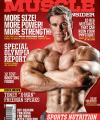Freak Fitness

As a strongman competitor, Darren has pulled 50,000 lb trucks and dead lifted 805 lbs. As a competitive bodybuilder, he has won Provincial Super-heavyweight & Overall titles. As President & CEO of FREAK Fitness, he has coached his clients to hundreds of Novice, Provincial/State, National, and IFBB Pro titles. Having been involved in the sport of bodybuilding for over 20 years, Darren has his finger on the pulse of the local and international bodybuilding scenes, and will be keeping you informed through his column, “Freak Fitness."

The Huge Advantages Bodybuilders Today Have Over Schwarzenegger's Era
As I was preparing diet and training program updates for my clients who were competing in the Arnold recently, I began to think about how the sport of bodybuilding has evolved since the days when Arnold was making a name for himself in the industry.
Gyms & Equipment
When Arnold first started out, bodybuilding gyms were few and far between. Major cities had only one or two gyms where all the bodybuilders trained, and many of those gyms were ill-equipped by today’s standards. Just barbells, dumbbells, a pull-up bar, and a few benches.
Today, we have fully equipped commercial gyms everywhere that have free weights like gyms of the past did, but we now also have access to weight machines that are engineered to isolate specific muscles and, in some cases, even select where in the range of motion the most resistance is applied.
Weight Training
In 1970, on his way to his first Mr. Olympia title, Arnold trained for up to five hours a day. Eventually, he would have to split up his workouts into two sessions a day so that he could still have time during the day to run his construction and mail-order businesses.
In 1974, then-newcomer Lou Ferrigno was known for training six hours a day in preparation for his Mr. Olympia debut.
Don’t get me wrong, these guys trained hard, but by today’s standards, most would consider that overtraining.
Today’s most widely accepted research shows that weight-training workouts should not go beyond 60 to 75 minutes. Today, we look for ways to increase intensity rather than increase volume to build more muscle.
Today we have the advantage of decades of scientific research that has determined the best practices, best exercises, and ideal variables that affect everything from optimizing muscle growth to strength, power, and endurance, as well as all sorts of data.

Nutrition and Supplements
In 1967, in preparation for his first Mr. Universe win, Arnold knew he would have to come in bigger and stronger. For months leading up to the competition, Arnold focused on eating as much protein and calories as he could handle. His protein shake of choice was a combination of brewer’s yeast, whole milk, and raw eggs.
Nutrition and supplementation science are much more advanced now. Today, it’s widely accepted that all-out “bulking” isn’t necessary for most bodybuilders to gain mass. Further, today we have access to higher-quality proteins such as whey isolate and branched-chain amino acids to help us build more muscle and elevate protein synthesis, in addition to ergogenic aids such as creatine and pre-workout nitric-oxide boosters to increase our performance in the gym.
Coaches
It’s fair to say that Arnold didn’t become successful on his own. He had friends such as Franco Columbu and mentors such as Joe Weider who supported him along the way. But Arnold never hired a coach to help him prepare for his competitions. Just like other bodybuilders of his time, Arnold learned everything on his own, mostly through trial and error.
Today, most bodybuilders—from novice to Mr. Olympia—hire coaches to oversee their nutrition, training, or both. Top-level coaches like me have made it our profession to become experts in the art and science of contest preparation, and bodybuilders can now take advantage of having an experienced coach in their corner to give them a definitive edge over their fellow competition. Even if you don't want a top coach, certification programs offer degrees that require a substantial amount of knowledge, so many certified personal trainers have the necessary educational background above and beyoind what used to be the standard.
Procuring Information
Just a few decades ago, with no Internet, face-to-face conversations between bodybuilders were the limited means by which insider information was passed. Muscle magazines were in their infancy targeted at the general population in those days, with publishers often serving as gatekeepers in terms of what and how much was being communicated. Today, clearly, quite the opposite is true: Access to information is just a mouse click away, but unfortunately, much of it isn’t vetted for accuracy.
Still, it’s super-easy today to access athletes, coaches, and trainers, and order supplements and programs online.
In Conclusion
The bodybuilding industry—both sport and recreational activity—has come a long way since the Arnold’s era. Thanks to scientific evolution, there has never been a better time to be a bodybuilder.

